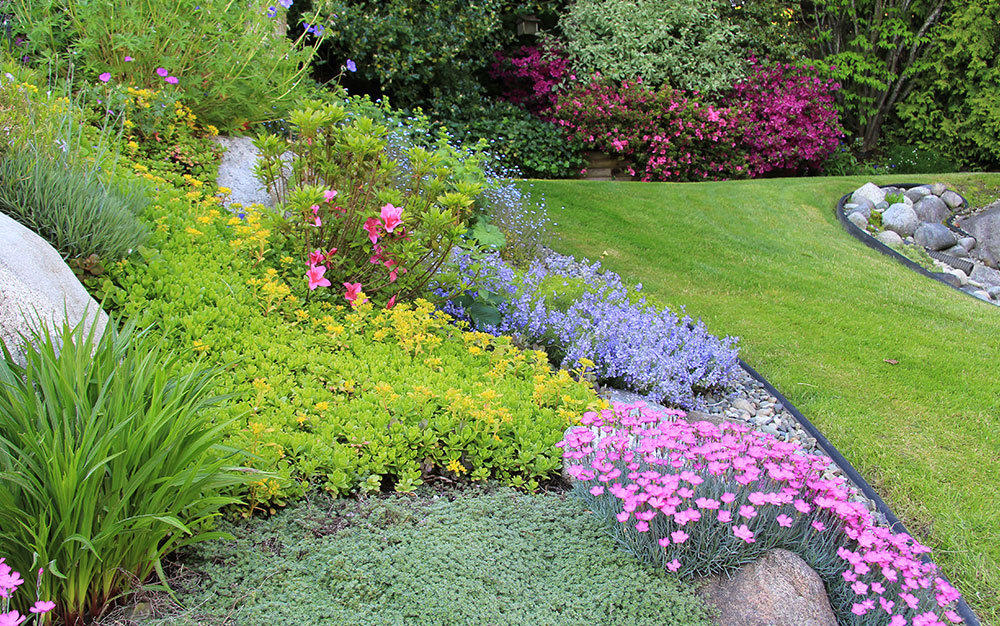Carpet the bare patches in your garden with fantastic foliage and flowers to create stunning ground cover.
Perfect plants for this purpose are both low-growing and low-maintenance and many are evergreen for great cover in your garden all year round. Flowers and fruiting plants will add something special to the areas, which will encourage wildlife to enjoy the shelter. As well as giving your garden a polished and complete look, ground cover plants will suppress weeds, insulate the soil and lock in moisture over the cooler, drier months.
Prime position
Used in beds, borders and at the base of trees, ground cover adds a really classy finishing touch that will bring your garden together.
When picking plants, consider the spot that you want to cover. Is it shaded or in sun for most of the day? And before you get planting, be sure to tackle any weeds. Dig up perennial weeds and try to get all of their root system out so they don’t grow back.

Got you covered

Evergreen plants will provide structure, colour and texture all year round, so you will never have to worry about your borders looking barren. Depending on the site that you are looking to fill, there are plenty of undemanding and reliable choices for continuous cover.
For a lot of bang for your buck, try Cotoneaster dammeri ‘Coral Beauty’. The leaves of this evergreen shrub are small and simple, joined by small white-cream blooms in summer.
But this performer doesn’t stop there. In autumn the bush is adorned with, orange-red berries, popular with birds. So by planting a Cotoneaster in your garden, you’ll attract visitors like blackbirds, waxwings and thrushes.
Flowering favourites
Firstly, Pachysandra terminalis (Japanese spurge) is a mat-forming evergreen that grows to 25cm tall and spreads to some 1.5m wide. It can be grown in any type of soil but be aware that in moist soils it can take over. Perfect for a fully or partially shaded spot in a cottage, courtyard or city garden, its glossy green leaves are joined by spikes of tiny, white flowers in early summer.
For flowers with a bit more oomph, Hypericum calycinum (rose of Sharon) is a cheery choice that has long-lasting blooms from June to September.

The intriguing orange, star-shaped flowers have fluffy looking anthers. And the ovate, deep green leaves produce a delightful scent when squeezed slightly. Pollinators will approve of this choice too, so plant it where the flowers will flourish – in full sun or partial shade, in a well-drained soil.
Popular picks

Vinca major and vinca minor, or periwinkle as they are more commonly known, are vigorous evergreens that are very popular – probably because they are easy to grow.
In fact these plants are so easy they can be invasive. But they can be put to good use in larger wilder areas of your garden, or in a border with mature trees and shrubs.
Happy in any soil, apart from very dry spots, these hardy plants don’t mind a shaded or sunny site, though their violet-blue flowers will bloom best when positioned in full sun.
A plant that we all love is the rose. So what better way to add something special to your garden than with roses as ground cover?
The showy flowerheads of Rosa ‘Pheasant’ are large deep-pink clusters with a light fragrance. They can repeat flower in full sun or partial shade so there will be flowers for a longer period of time to appeal to pollinators like bees.
For a lighter bloom, Rosa ‘Snow Carpet’ is exactly what it sounds like – small white flowers that bloom in sprays and form a carpet of white. This lovely plant will repeat flower from spring until autumn. Plant it is full sun in a well-drained spot to keep the flowers flourishing.
Selections for the senses
For a striking choice full of texture, Stachys byzantina (lambs’ ear) ‘Silver Carpet’ has grey-white leaves that look soft and woolly, making it an interesting choice for filling a low space. When grown in full sun in a well-drained soil, this hardy perennial can spread up to 1 metre.
For fragrant ground cover try some thyme. Thymus praecox (creeping thyme) is low-growing and forms a dense mat of foliage that smells and tastes like a mix of lemon and mint.

Its hardiness also means it’s can tolerate being trampled on, making it a great survivor if you have kids. Whether you want to reduce the amount of weeding in your garden, or spruce up your borders with constant colour, flowers or fruit, there are plenty of options to suit your garden style and the space you have.
Tip:
Twist black bin liners or old pairs of tights and
use them as ties to support young trees in the seasonal gales.
Both are long-lasting and cheap methods.
These plants really have it covered.
Happy gardening everyone!
Reader questions
I had a successful tomato harvest in my greenhouse this summer. But what veg can I grow there in autumn and winter?

Over the darker months, you need to ensure greenhouse plants get as much light as possible. But you can grow winter salads like hardy lettuces, pak choi and spinach as well as herbs. Early next year sow broad beans and carrots ready to plant out in spring.
Why won’t my lavender plants grow? I grow them in pots, and they always die after flowering.

They may not have enough sunlight. These plants like about eight hours of it a day. Or they may have been overwatered. Remember, lavender hails from the Mediterranean. And they don’t like harsh winters. So keep them on a windowsill in the worst of the weather.

Leave A Comment